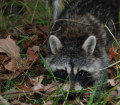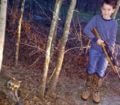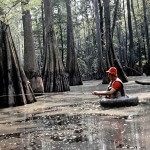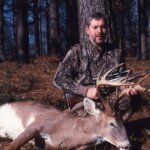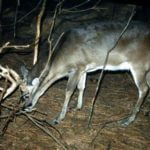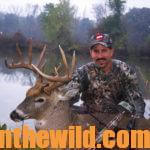Editor’s Note: To improve the habitat and the amount of wildlife on your hunting lands, hunt coyotes, feral hogs, foxes, raccoons, possums and bobcats. The more predators you can remove from the property you hunt between now and deer season, the more you’ll protect wildlife habitat, and the more food your wildlife will have. As Michael Johnson, a predator trapper and hunter from Plainfield, Georgia, explains, “Since I’ve been hunting these predators on my family’s land, we’ve seen a tremendous increase in the number of turkeys. I trap predators too because they’re very-smart animals and often may spook before we can take our shots. Predators are like cockroaches – you can beat their numbers back but never entirely get rid of them.”
 According to Johnson, “Most people don’t think about raccoons and possums as being detrimental to wildlife. They generally consider bobcats, coyotes and foxes as being problems. But when you want to increase turkey populations, the raccoons and possums are much-more damaging to turkeys because they’ll destroy wild turkeys eggs and nests and often kill hens sitting on their nests. So, if a coon or a possum finds a hen turkey that is holding tight on the nest no matter what, and they kill and eat her as well as her eggs, that predator has reduced the number of available turkey hens, as well as the number of poults that would have been born that year. Planting food plots, doing prescribed burns and manipulating the habitat for turkeys are all good practices to increase turkey populations. However, if you overlook predator control, you’re leaving out a very-important and critical element of turkey management.
According to Johnson, “Most people don’t think about raccoons and possums as being detrimental to wildlife. They generally consider bobcats, coyotes and foxes as being problems. But when you want to increase turkey populations, the raccoons and possums are much-more damaging to turkeys because they’ll destroy wild turkeys eggs and nests and often kill hens sitting on their nests. So, if a coon or a possum finds a hen turkey that is holding tight on the nest no matter what, and they kill and eat her as well as her eggs, that predator has reduced the number of available turkey hens, as well as the number of poults that would have been born that year. Planting food plots, doing prescribed burns and manipulating the habitat for turkeys are all good practices to increase turkey populations. However, if you overlook predator control, you’re leaving out a very-important and critical element of turkey management.
“We realize we’ll never wipe out all the coons, possums and coyotes on the lands we and our friends hunt, but by reducing the number of predators in a single year, we can see more turkeys and deer be born and survive than if we don’t do predator control. To have more turkeys, you need to conduct a well-planned predator-control program on your hunting lands every year.”
Patterning Predators:
Johnson mentions that in one year, he caught five bobcats out of the same trap placed in the same hole. “The following year, we caught four bobcats in that same trap. So, we learned that you can pattern predators much like you pattern deer. Year after year, predators will return to some of the same places where you’ve caught them previously. Predators are much like cockroaches and wild hogs – you can beat their numbers back, but you’ll never entirely get rid of them.”
 Trapping Beavers, Coyotes and Bobcats:
Trapping Beavers, Coyotes and Bobcats:
Johnson has some landowners he traps for who were having problems with beavers flooding much of their hunting lands. “When they asked us to trap beavers, we agreed and bought some Conibear traps. But we quickly learned that trapping beavers was a lot of hard work. You have to break the dam, which takes about 3 hours, set the trap and catch the beaver. But then those beavers left will return and have that break you’ve made in the dam built back overnight. We’re really just getting started on beaver trapping, and we’ve caught about five. We’ve heard that beavers are good to eat, and the next one we catch, we’re going to cook it the same way we cook raccoons. Beavers aren’t our main target. However, if some of the landowners we work with are having problems with beavers, we’ll try to solve that problem too.
 “My favorite animals to catch are coyotes and bobcats. They’re the two smartest animals in the woods in my thinking. Those animals realize you’re in the woods, and when I get one of those animals to put its paw on a 2-3 inch trigger, I feel I’ve really done something. My friends and I have learned that various areas produce different types of predators. In the regions where we catch gray foxes and bobcats, we don’t catch very-many coyotes. However, in the places where we do catch numbers of coyotes, we don’t see very many bobcats and gray foxes. We’ve learned that the bobcats and foxes don’t like coyotes, and the coyotes don’t like the bobcats and foxes.”
“My favorite animals to catch are coyotes and bobcats. They’re the two smartest animals in the woods in my thinking. Those animals realize you’re in the woods, and when I get one of those animals to put its paw on a 2-3 inch trigger, I feel I’ve really done something. My friends and I have learned that various areas produce different types of predators. In the regions where we catch gray foxes and bobcats, we don’t catch very-many coyotes. However, in the places where we do catch numbers of coyotes, we don’t see very many bobcats and gray foxes. We’ve learned that the bobcats and foxes don’t like coyotes, and the coyotes don’t like the bobcats and foxes.”
** Be sure to check your state’s regulations about trapping and hunting predators. **
To learn more about hunting, check out John E. Phillips’ print, Audible and Kindle books at https://johninthewild.com/books/. You also can download a free Kindle app that enables you to read the book on your iPad, computer or SmartPhone.
Tomorrow: Taking Raccoons

